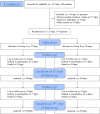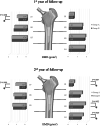Comparison of Bone Preservation in Elderly Patients with Femoral Neck Fracture After Bipolar Hemiarthroplasty Using Shorter Femoral Stem and Standard Femoral Stem
- PMID: 33133410
- PMCID: PMC7572964
- DOI: 10.1007/s43465-020-00115-5
Comparison of Bone Preservation in Elderly Patients with Femoral Neck Fracture After Bipolar Hemiarthroplasty Using Shorter Femoral Stem and Standard Femoral Stem
Abstract
Background: This randomized control study was designed to compare the clinical and radiological outcomes, including periprosthetic bone mineral density (BMD) changes, between the short and standard stems after using cementless hemiarthroplasty in elderly patients with femur neck fractures.
Materials and methods: From January 2013 to May 2017, 151 patients (aged ≥ 65 years) underwent hemiarthroplasties due to femoral neck fractures. Patients were randomized into two groups; 77 patients in Group A implanting the short femoral stem and 74 patients in Group B implanting the standard femoral stem. Clinical and radiographic evaluations were performed in all patients.
Results: 75 patients (40 patients in Group A and 35 patients in Group B) completed routine follow-up for a minimum of 2 years. The clinical outcomes, including ambulatory functions and thigh pain, were similar in both groups. All the femoral stems acquired radiologic stability. At postoperative one year, BMD values in Gruen zone (G) seven on the standard stem side were significantly lower than those on the short stem side (P = 0.038). At the second year of follow-up, the BMD values of Group A in G1, G3, G4, and G7 were significantly greater than those of Group B (P = 0.007, 0.032, 0.026, and P < 0.000, respectively).
Conclusions: Both the clinical outcomes and radiologic stability in both group demonstrated similar results in elderly patients with femoral neck fracture at the latest follow-up. In addition, the periprosthetic BMD of the short femoral stems demonstrated better periprosthetic bone preservation at a minimum of 2 years of follow-up.
Level of evidences: Therapeutic Level II.
Keywords: Elderly; Femoral neck fracture; Hemiarthroplasty; Periprosthetic bone preservation; Short stem.
© Indian Orthopaedics Association 2020.
Conflict of interest statement
Conflict of interestNo benefits in any form have been received or will be received from a commercial party related directly or indirectly to the subject of this article. Each author certifies that he or she has no commercial associations (e.g., consultancies, stock ownership, equity interest, patent/licensing arrangements, etc.) that might pose a conflict of interest in connection with the submitted article.
Figures





References
-
- Burgers PT, Van Geene AR, Van den Bekerom MP, et al. Total hip arthroplasty versus hemiarthroplasty for displaced femoral neck fractures in the healthy elderly: a meta-analysis and systematic review of randomized trials. International Orthopaedics. 2012;36:1549–1560. doi: 10.1007/s00264-012-1569-7. - DOI - PMC - PubMed
-
- Morrey BF. Short-stemmed uncemented femoral component for primary hip arthroplasty. Clinical Orthopaedics and Related Research. 1989;249:169–175. - PubMed
LinkOut - more resources
Full Text Sources
Research Materials
